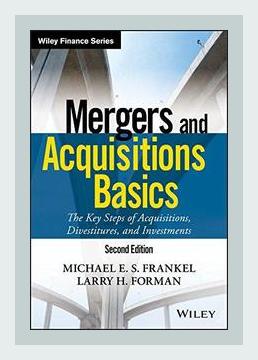Business StrategyMergers and Acquisitions
**
I. Introduction
Anthony Tarantino’s “Mergers and Acquisitions: A Step-by-Step Guide” serves as a comprehensive manual for navigating the complexities of mergers and acquisitions (M&A). Structured to assist both novices and seasoned professionals, this book enumerates detailed strategies, practical steps, and real-world examples to demystify the process of M&A. Each chapter covers a specific phase of the M&A lifecycle, enabling readers to effectively manage each stage.
II. Setting the Strategy (Chapter 1)
Key Point: Building a sound M&A strategy is crucial for the successful execution of any acquisition or merger.
Action Step: Conduct an internal assessment to determine strategic goals.
* Example: Tarantino illustrates how a software company identified its need to expand its service offerings. The company assessed its capabilities and decided to pursue acquisitions that aligned with its goal of diversifying its product range.
III. Due Diligence (Chapter 2)
Key Point: Thorough due diligence is essential to uncover risks and validate the targeted company’s valuation.
Action Step: Assemble a cross-functional team to evaluate financials, operations, and legal/regulatory aspects.
* Example: A case study involving a manufacturing firm revealed that operational inefficiencies in the target company could be streamlined post-acquisition, ultimately providing cost savings and operational synergies.
IV. Valuation (Chapter 3)
Key Point: Accurate valuation methods are imperative for determining a fair price for the target company.
Action Step: Utilize multiple valuation methods such as Discounted Cash Flow (DCF) analysis, comparable company analysis, and precedent transactions.
* Example: Tarantino describes how a retail chain used a combination of DCF and earnings multiples to assess the value of a potential target, ensuring they paid a justified price that would also offer a good return on investment.
V. Negotiation (Chapter 4)
Key Point: Effective negotiation tactics can make a significant difference in closing a successful deal.
Action Step: Prepare thoroughly, knowing both your own and the target company’s strengths and weaknesses, and aim for a win-win outcome.
* Example: In a case where a tech startup negotiated with a larger conglomerate, the startup leveraged its cutting-edge technology as a strong bargaining chip, while the conglomerate offered access to extensive distribution networks in return.
VI. Financing and Structuring the Deal (Chapter 5)
Key Point: The structure and financing of the deal are critical to its success and should align with the strategic objectives.
Action Step: Explore various financing options such as equity financing, debt financing, or a mix of both.
* Example: Tarantino discusses how an energy company used a mix of debt and equity financing to acquire a renewable energy firm, thereby leveraging tax advantages and minimizing upfront cash outlay.
VII. Closing the Deal (Chapter 6)
Key Point: Attention to detail during the closing process ensures all aspects of the deal are legally binding and risk-free.
Action Step: Conduct a thorough final review of all documents and ensure all legal and regulatory requirements are met.
* Example: The book provides an instance where a healthcare company meticulously conducted a final audit and compliance review, preventing any last-minute legal challenges and closing the deal smoothly.
VIII. Post-Merger Integration (Chapter 7)
Key Point: The integration phase is critical for realizing the expected synergies and avoiding post-merger pitfalls.
Action Step: Develop an integration plan that includes cultural alignment, operational integration, and communication strategies.
* Example: In an acquisition of a smaller engineering firm by a multinational corporation, the integration team focused on aligning corporate cultures by conducting joint workshops and cross-training sessions, which facilitated smoother operational merges and employee cooperation.
IX. Case Studies and Real-World Scenarios (Chapter 8)
Key Point: Learning from real-world examples provides valuable lessons and best practices.
Action Step: Study various case studies to understand the diverse challenges and solutions in different industries.
* Example: Tarantino recounts failed deals, such as the hostile takeover attempt in the telecommunications industry where the acquiring firm underestimated the regulatory challenges and cultural mismatches, leading to an aborted merger.
X. Legal and Regulatory Considerations (Chapter 9)
Key Point: Complying with legal and regulatory frameworks is non-negotiable.
Action Step: Engage legal experts early in the process to navigate antitrust laws, securities regulations, and other legal considerations.
* Example: A pharmaceutical company’s acquisition was nearly derailed due to antitrust concerns, but proactive engagement with legal counsel and regulators helped negotiate terms that satisfied all parties.
XI. Reassessing and Learning (Chapter 10)
Key Point: Continuous reassessment and learning from each M&A transaction improves future execution.
Action Step: Conduct post-mortem reviews after each deal to identify and document lessons learned.
* Example: A financial services firm incorporated insights from previous deals into a new standardized M&A playbook, which improved efficiency and success rates in subsequent mergers.
Conclusion
“Mergers and Acquisitions: A Step-by-Step Guide” by Anthony Tarantino offers a detailed roadmap enriched with examples across various industries to guide professionals through the intricacies of the M&A process. The actionable steps and concrete examples provided for each stage—from strategy setting to post-merger integration—equip readers with the knowledge to execute successful M&A transactions consistently. The emphasis on due diligence, effective valuation, strategic negotiation, and meticulous post-merger integration underscores the comprehensive approach necessary to navigate the multifaceted world of mergers and acquisitions.
